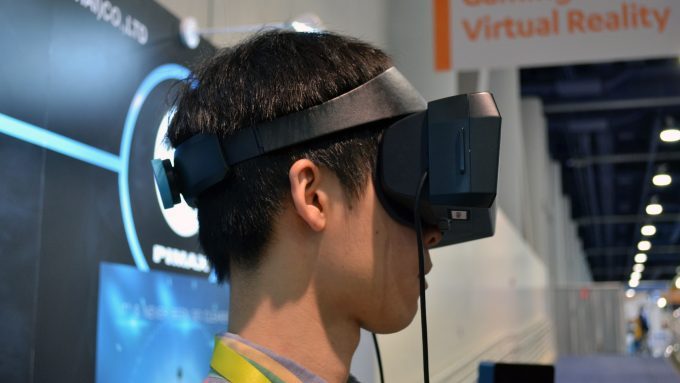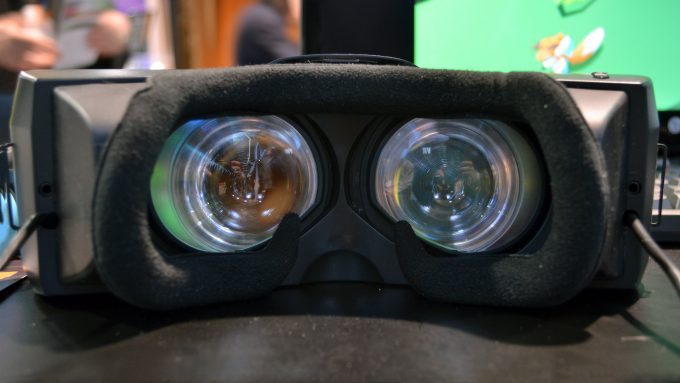Frank He goes hands on with PiMAX’s ludicrously high-spec 8k, 200 degree FOV prototype at CES and find the company has some innovative solutions to some of the substantial challenges driving a headset like this poses.
While there were many perhaps questionable Chinese VR headsets shown off at CES this year, Pimax’s new 8K, 200 degree prototype actually stood out from the crowd. Moreover, Pimax perhaps even showed both some of the potential that high spec headsets might provide along with the challenges associated with getting the details right. Not only was I able to give the new headset a try, I was also able to learn more about how exactly they intend to address the significant challenges behind powering a headset that boasts a 3840 x 2160 per eye resolution.
The exterior of Pimax’s new prototype bears some resemblance to Starbreeze’s 210 degree StarVR headset (and the InfinitEye before it) but uses a PlayStation VR (PSVR) style mounting mechanism. Each of the headset’s displays (one per eye), are placed at a canted angle, just like StarVR’s. In terms of heft, the Pimax unit didn’t seem that much heavier than the PSVR upon use, although as ever, it’s hard to judge this accurately given that it was just a short demo. One thing’s for sure though, the bulky shell makes it look heavier than it actually feels.
 The headset’s resolution was probably the best thing about the headset. Whilst inside, I couldn’t discern individual sub-pixels no matter how hard I looked – whereas with the Rift or Vive I can. It took some effort to even discern individual pixels. The result was that it felt like I was looking at a slightly textured surface or film, similar to the current headsets, but much sharper and transparent. I can imagine I wouldn’t be distracted by the resolution.
The headset’s resolution was probably the best thing about the headset. Whilst inside, I couldn’t discern individual sub-pixels no matter how hard I looked – whereas with the Rift or Vive I can. It took some effort to even discern individual pixels. The result was that it felt like I was looking at a slightly textured surface or film, similar to the current headsets, but much sharper and transparent. I can imagine I wouldn’t be distracted by the resolution.
The FOV (Field of View) was also impressive, feeling close to the aforementioned StarVR’s. Of course, the ultra-wide FOV was beneficial to peripheral awareness, but in terms of actual added immersion, I’m not sure if there was much of a real benefit. However, there were a few issues which perhaps hindered this. Issues include low brightness from the displays, weird inconsistent warping or geometric distortion when getting farther away from the center of the lenses, an inaccurate distortion profile in general, a low binocular overlap (the volume of FOV that overlaps between both eyes), and a very little bit of ghosting and/or smearing in motion. All of these issues unfortunately formed a barrier against proper immersion in the game. The low binocular overlap seemed to be the biggest immersion killer alongside the warping/distortion, whilst the low brightness and smearing were slight – far beyond that found in the Oculus Rift DK1 of course. It’s uncertain whether more time to play around with the IPD adjustment and time to get used to the distortion would have improved the experience.
Pimax are also using fresnel lenses in this new headset, but interestingly, the ‘godray’ artifacts usually associated with these type of optics were actually very subtle. It’s entirely possible however that the low brightness of the displays may have played a part in that.
So alas, presence was non existent for me. However, playing Lucky’s Tale and Radial-G: Racing Revolved on the headset I could see how, once distortion is reduced and that binocular overlap increased, it might truly represent a new jump in visual quality for VR.
 All that aside, how exactly do Pimax expect people to drive two sets of 4k displays at higher enough refresh rates needed for good, low latency VR? Enter ‘Brain-warp’. Brain-warp is a technique where you render and display an image to one eye only, and then render and display for the other eye, in a sequence such that one eye is seeing an image and the other isn’t at any given moment in time. This way, they’re actually rendering a single 4K image at 120 times a second, but the user perceives it as a complete 8K image at 120Hz. How? Because that frequency is high enough that we don’t perceive that one eye is blind while the other isn’t, at least for a tiny fraction of a second. It’s like raising one hand to one eye, lowering that hand and raising your other hand to your other eye, and doing that very so fast that you simply don’t notice it. Active-shutter 3D glasses use the same concept, often at the same 120Hz refresh rate.
All that aside, how exactly do Pimax expect people to drive two sets of 4k displays at higher enough refresh rates needed for good, low latency VR? Enter ‘Brain-warp’. Brain-warp is a technique where you render and display an image to one eye only, and then render and display for the other eye, in a sequence such that one eye is seeing an image and the other isn’t at any given moment in time. This way, they’re actually rendering a single 4K image at 120 times a second, but the user perceives it as a complete 8K image at 120Hz. How? Because that frequency is high enough that we don’t perceive that one eye is blind while the other isn’t, at least for a tiny fraction of a second. It’s like raising one hand to one eye, lowering that hand and raising your other hand to your other eye, and doing that very so fast that you simply don’t notice it. Active-shutter 3D glasses use the same concept, often at the same 120Hz refresh rate.

Brain-warp is a neat trick then, but not without its downsides and clearly there’s still a huge amount of power needed to drive the displays in this headset. To output 4K at 120Hz, they say you’ll need at minimum an NVIDIA GTX 980 but that’s assuming Async Timewarp is also in play helping resolve dropped frames. Their actual recommended specification however is either dual GTX 1070s, or one GTX 1080.
Another caveat here is that brain-warp also requires “very accurate synchronous fine tuning” according to them, and results in a “ghosting” artifact that appears during motion. That artifact wasn’t very distracting to me in the demo, but it may be more distracting at higher brightness levels or other scenarios.
Pimax say they’re using custom LCDs in their headset in order to drive the display’s response time down and to achieve low persistence. My experience with the headset was that it did exhibit the smearing associated with typical LCD HMDs, but to a smaller extent than you might expect. As such, they state that this prototype can achieve a the motion-to-photon latency of 18ms.
They still have yet to demonstrate positional tracking and motion controllers, both of which they’ve announced. Valve has of course now opened up their Lighthouse tracking tech for it to be used by anyone on anything. It’ll be interesting seeing which route Pimax pick, given the fact that they already supporting SteamVR.
As this was a prototype, there’s no release date yet, but they have announced that the company will take to Kickstarter with the new device. At their Gearbest storefront at least, the price is listed as $599, but this may well be subject to change.







